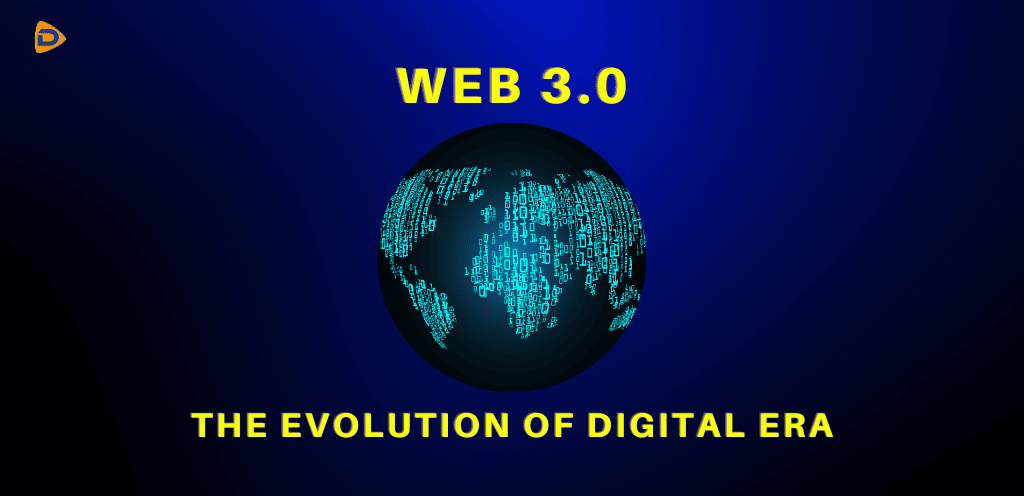
A blog around an explanation of the technologies behind Web 3.0.
Have you ever wondered whenever you search for any product on the internet, later you will notice advertisements for that product everywhere on the internet?
Sometimes it is useful but most of the time very annoying.
It is an unfavourable point of web 2.0 that can influence users’ privacy issues.
Because currently, only one or two giant companies ruled over the internet. For example, Google has 76% and 86% of the Global search market via desktop and mobile, respectively.
Chrome makes up over 67% of the Global Search Market, touching 2.65 bn users worldwide.
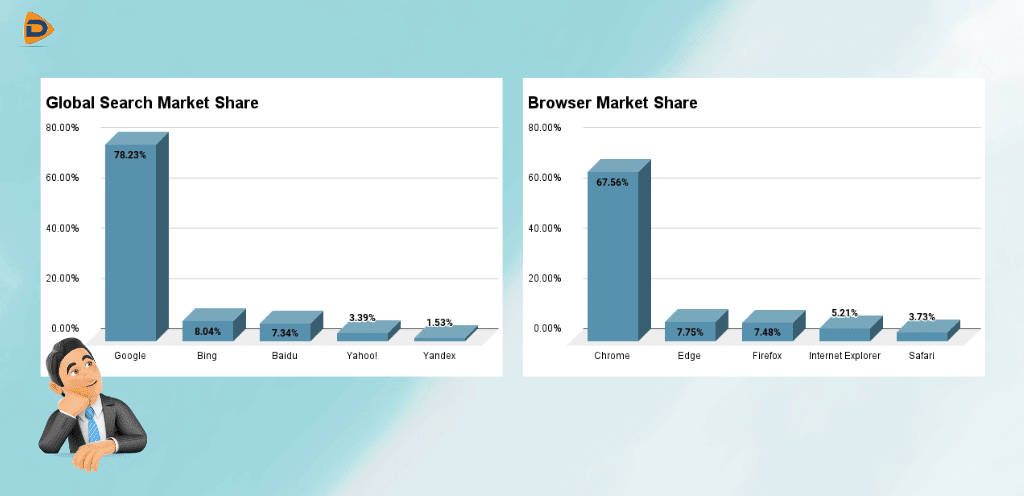
This market control means that Google can leverage its browser dominance and change regulation as they please.
Have you heard recently Facebook reaching 3.6 bn new users?
Who gave the right to these companies to control the internet? And use this data on advertisements?
One recent example is Apple’s launch of iOS 14.5 with features where users can choose to allow the “app to track your activities across other companies’ apps & website”.
This feature creates a problem for Facebook, which estimates it will lose $10bn in 2022.
Because of one privacy feature, that is part of one iPhone.
Finally, this is the time when users grab all the powers in their hands,
It is the goal of WEB 3.0.
What is Web 3.0?
To get rid of loopholes in current Web 2.0, the internet gave birth to a new evaluation of the Internet Web 3.0.
Web 3.0 can be defined as allowing the internet to process data with near-human intelligence through the use of Artificial Intelligence and Blockchain technologies that run innovative programs to help users by providing them with relevant choices.
Web 3.0 is the next generation of the internet, and offers a number of new benefits, tools and services for users to access information, make choices and be rewarded for their online interactions.
In this post we will look at:
- What is Web 3.0?
- What is the difference between Web1.0, Web 2.0 and Web 3.0?
- Web 3.0 Features/ Technologies
- What are the Advantages of Web 3.0
- What are the Disadvantages of Web 3.0
- Web 3.0 Examples
Evaluation of Internet
If Web 3.0 is enforced, there will not be an abrupt break between the two, instead like in the previous evolution, where changes were made little by little. However, we can see big contrasts between the two.
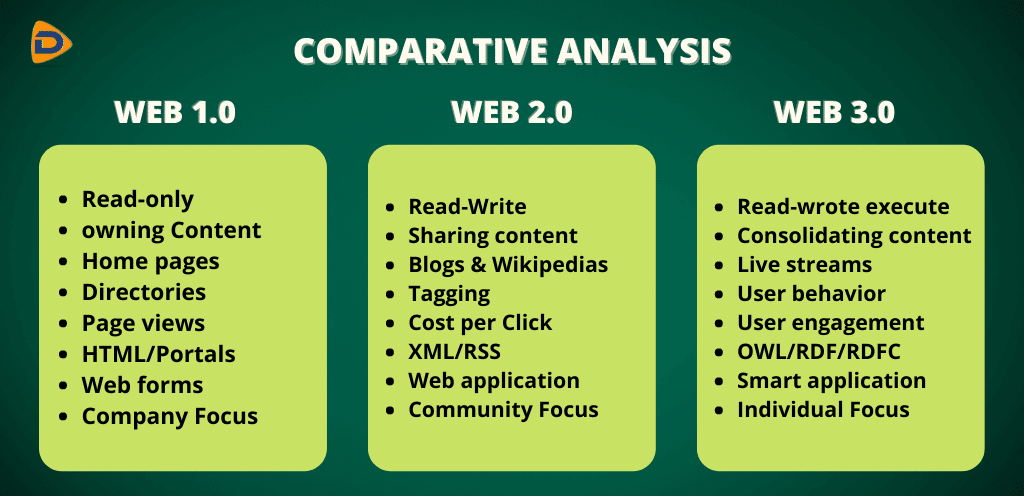
To understand deeply WEB 3.0, you need to understand Web 1.0 and Web 2.0.
Static web 1.0
Web 1.0 statically displayed relevant data, with little user engagement with web materials. For example, giving out remarks or modifying and generating website material.
That era of the Web was denoted by the centralisation of content production – such as portals, AOL and directories, and Yahoo.
Key Components of Web 1.0 were –
- TTP(Hyper Text Transfer Protocol)
- URL(Uniform Resource Locator)
- HTML(Hypertext Markup Language)
Social web 2.0
Web 2.0 is just the opposite of Web 1.0. It has material created especially by its customers in a system where people both create and consume content.
For Example, Wikipedia or user-generated content platforms like blogs, social networks and YouTube.
Mobile internet was also one of the major aspects of this evolution. With the help of big companies like Apple, Google, Amazon, and Facebook, people could now share their experiences, businesses, etc with the world as well.
They made users depend on to share their data worldwide via their platform and because of this, ownership of the shared data became a big issue.
Identity theft is the most recognised reason, why web 3.0 was needed.
Semantic Web 3.0
Web 3.0 or Semantic web is a combination of both Web 1.0 and Web 2.0 with the addition of machine Intelligence.
The creator of the Web, Tim Berners-Lee (2001), set up the foundation of the Semantic Web and published an article in Scientific American magazine.
Web 3.0 is the era of the development of Blockchain technology and decentralisation application.
This is the next phase of Intenet where we will see the advancement of Blockchain technology-based Platforms that will decentralise pretty much every part of our life.
Until now giant companies like Google, Amazon and Facebook are using the data of People without compensating them.
Now with the help of Web 3.0, People can claim ownership of their data and share them without losing privacy.
With the help of Artificial Intelligence and Machine learning, people can communicate with machines just like they communicate with others.
Web 3.0 Technology
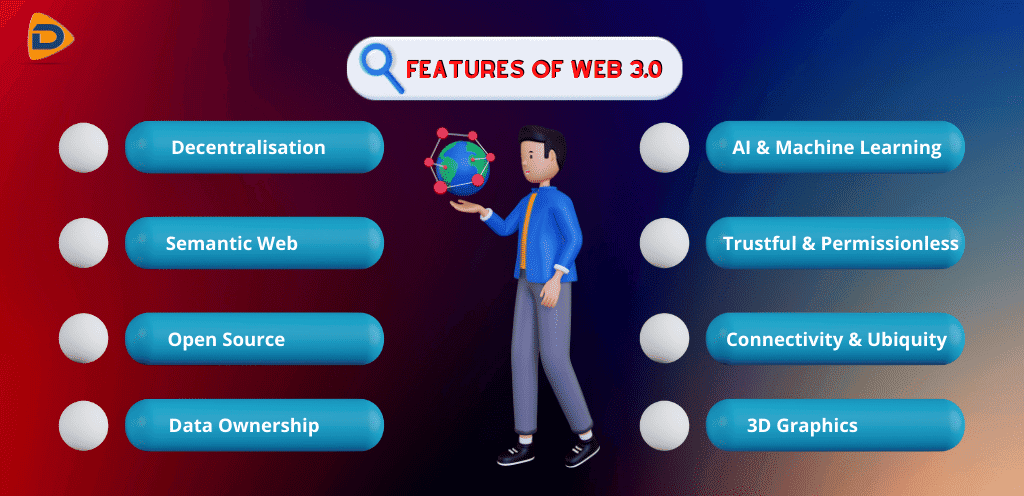
- Decentralisation
Decentralisation is the core feature of Web 3.0. It uses Blockchain technology.
Blockchain is a very secure technology where data will be stored in different blocks in the form of a chain that is very difficult to hack.
The motive behind this technology in Web 3.0 is to distribute the power in the hand of big companies to Everyone.
Because Web 3.0 allows information to be retrieved based on its content. It can be kept in several locations simultaneously making it decentralised.
This way, users have more control over their data. This would also dismantle the vast database currently maintained by internet giants like Facebook and Google.
It can avoid the risk related to the collapse of the centralised servers.
- Semantic Web
This is the next step in the evolution of the web, which allows users to be more accurate and practical when searching for content.
The semantic web also allows customers to search for content based on exact meaning rather than keywords or page numbers.
- Open Source
Web 3.0 develop open-source software that is open and available to the public. All components of it manage transparently.
Like android, anyone can modify it according to their needs.

- Artificial Intelligence(AI) & Machine learning
With the technology based on the semantic web and machine learning, Natural language processing computers will be able to understand the information in the same way that people do.
In other words, Artificial Intelligence will help interpret data similar to human language.
For example, I Love Paris and I <3 Paris may seem different in syntax. However, their semantics are nearly identical.
This technique will help the users achieve more relevant content to their choices and will provide them ease with internet browsing.
- Trustful and Permissionless
Web 3.0 will be trustful and permissionless, as participants can interact directly without a trusted intermediary or permission from governing body.
Due to this, you can access any data relevant to your choice without any permission from any other node or third party.
For example, if you are looking/researching for some data, you don’t need to accept cookies or provide any details as there is a trustful bond between you and the web.
- Data Ownership
For many years, user-generated data is used and controlled by giant companies like Google, Facebook and Amazon for their Profitability.
End-users of Web 3.0 will have complete ownership of their data. They can make money by sharing information they create.
- 3D Graphics
Several innovators refer to Web 3.0 as the Spatial Web as it brings 3D virtual world into focus. We can see it commonly used in arts, gaming, and animation.
Because Web 3.0 aims to break the boundary between reality and virtuality by using 3-D graphics technology that converts fantasy reality into sharp relief.
Many web designers are starting to use 3d technology to make their websites more engaging and immersive.

- Connectivity and Ubiquity
In web 3.0, the internet will be accessible to anyone, anywhere and at any time because IoT(Internet of Things) technology will launch several smart devices.
These internet-connected devices will no longer be limited to PCs & smartphones as they were in Web 2.0.
As data storage is decentralised, there will never be a disturbance of services.
Even if one server is down, you can continue to do your work because data will be available on other servers.
Understanding the shortcoming of web 2.0 corporate like amazon, Google & Apple are transferring their existing services into Web 3.0 Apps that abide by these principles.
5- Pros and Cons of WEB 3.0
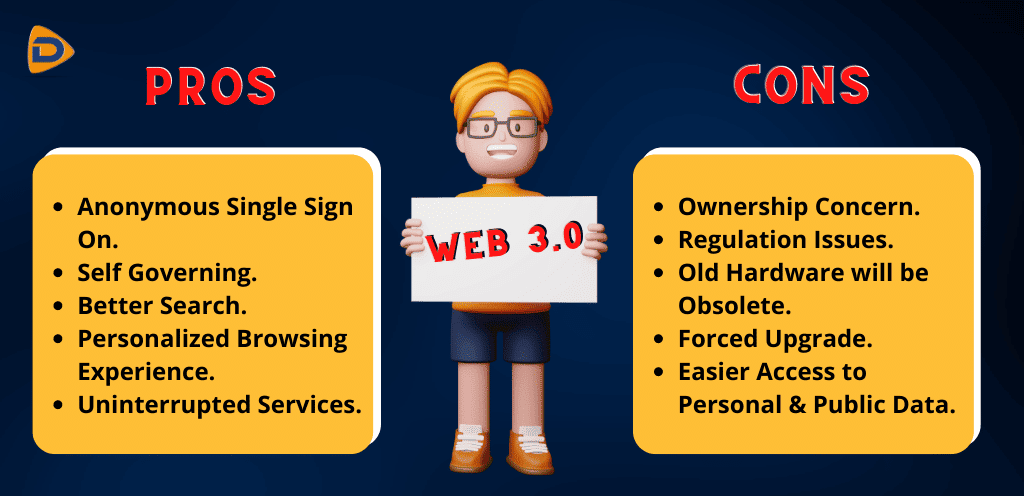
Advantages of Web 3.0
- Anonymous single Sign on
You do not need to create separate Users Profile for each platform. A single user profile will work on each platform, and you will have complete control over your data.
They can also sign in as an Anonymus which will protect their privacy.
- Self Governing
Because Web 3.0 follow the Decentralisation concept thus does not require a single entity to control it.
A big corporation like Google and Facebook can not govern any aspects of the Internet.
As a result, Decentralised apps can neither be censored nor their access restricted.
- Better Search
Because Web 3.0 uses Artificial Intelligence and Machine Learning technologies, you do not need to search on particular Keywords.
You can search queries by communicating with computers like you are communicating with other Human beings.
- Personalise Browsing Experience
Web 3.0 can comprehend your preference so you can personalise your browsing experience. Through this, working on Internet will become easier.
- Uninterrupted Services
Because Web 3.0 uses Blockchain technology, data is stored on different nodes or servers. If one server is down, then another server will continue to work.
So you do not need to worry about the suspension of services due to technical errors.
Disadvantages of Web 3.0
- Ownership Concern
Jack Dorsey, the Former CEO of Twitter, believes that projects of Web 3.0 will be owned by venture capitalists and investors.
Web 3.0 can not manage without a central body. Regular users can not be owners of Web 3.0 Projects.
- Regulation Issues
Some experts believe it will be challenging to regulate and monitor Web 3.0 because of Decentralised property.
It will lead to an increase in Cyber Crimes, online abuse, Hacking and much more.
- Old Hardware will be obsolete
Old hardware will not be able to manage web 3.0. You need new above-average specification devices to be able to use the next generation of the Internet.
- Forced Upgrade
As Web 3.0 become more popular, then existing industries will be forced to upgradation of their digital offering and not lose their capture market.
- Easier Access to Personal & Public Data
Although the semantic network is the strength of Web 3.0, there are also disadvantages.
These features of Web 3.0 will let anyone easily access the public and private data that you share online.
However, all these advantages and disadvantages are based on the available information. When actual Web 3.0 comes into use, it will be a lot different from current predictions.
Web 3.0 Examples
Apple’s Siri and Wolfram Alpha are examples of Web 3.0 applications. They can summerise a large quantity of information into valuable data for people.
- SIRI
Apple’s Siri is the most private intelligent Assistant. Siri uses techniques of speech recognition and Artificial intelligence to complete the task.
Siri is a voice-controlled personal assistant that provides a comfortable and friendlier way to make phone calls, send texts, use apps, and get things done with just your voice.
You just need to say “Hey Siri” and press buttons. For example, Hey Siri, where did I park my car? And Hey Siri, set an alarm for 8 AM.
Tools like Web 1.0 and Web 2.0 make search matching “word by word” that often brings enormous data but fails to bring the most relevant data for users at a time.
While Web 3.0 seeks contextual knowledge to assist users in their jobs, suggesting a series of analyses and potentially helping users.

- Wolfram Alpha
Wolfram Alpha is a computational knowledge engine and answer engine developed by Wolfram Research. It answers factual queries directly by computing the answer from externally sourced data.
Let’s start a comparative analysis between Google and Wolfram Alpha and then see the difference in the Results.
For example, India vs China
In Google’s case, the result turns out to be mostly related to economic news and their relations with each other. Note that Economics and Friendship were not mentioned in the search.
In Wolfram Alpha, the tool evaluates that the search is a comparison between two nations and accordingly fetches organised statistics, historical, geographical (maps), demographic, linguistic and other practical factors for comparative analysis.
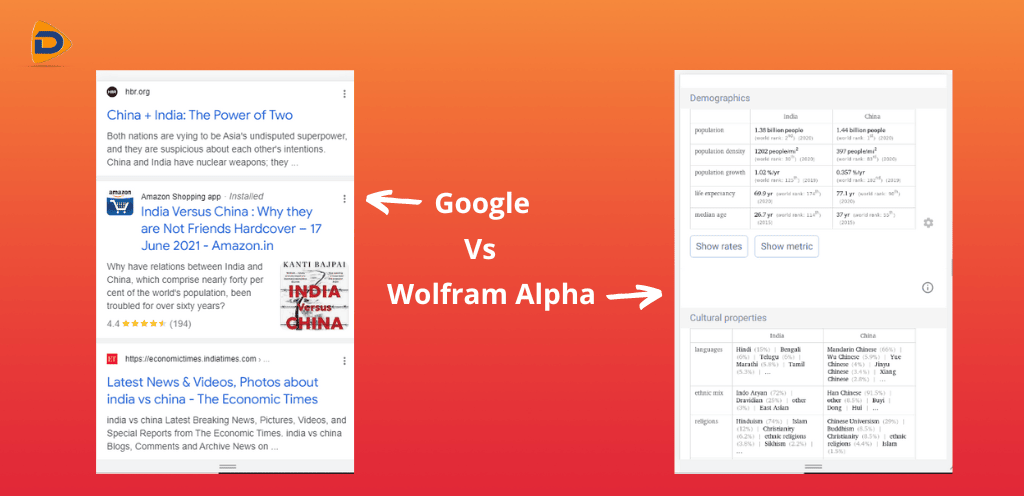
To wind-up
The internet has transformed the world for the more promising in many ways.
Since it is a decentralised web, You get ownership of the data you share on the Internet.
With the change of platforms, you can enjoy your privacy without having to get bugged by ads and other promotional stuff.
Web 3.0 is necessary because it permits businesses to ease their process by cutting down middlemen and directly connecting computers.
It will enable communication and cooperation between partners, employees, and customers, making Web 3.0 more profitable for businesses.
It will make your business more authoritative and get all-around transparency in all kinds of things.
Therefore with Web 3.0, the Internet is undoubtedly going to improvise the traditional mode of operations.
Some new businesses with the semantic web are already started to increase their momentum in the national and international markets.
Hence, not getting along with its evolution, leaders might bring organisational risks that suddenly evolve into outdated or irrelevant like the giant of the past such as Nokia and Kodak.
Device Doctor India is the best Website development company in Jaipur. We have the right number of highly skilled web developers who works for hundreds of clients.